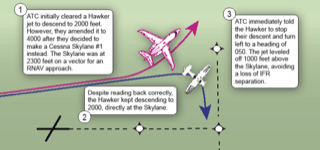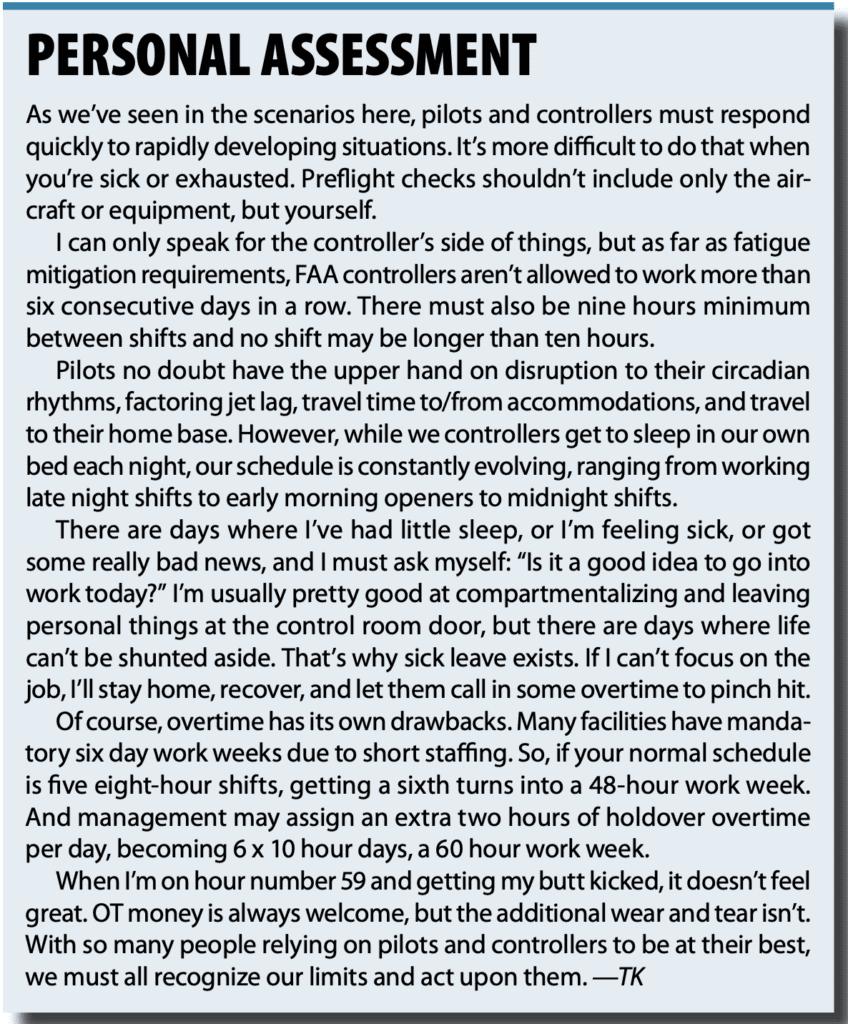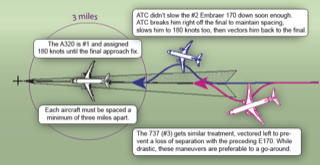Flight training isn’t just about learning the right way to do things. A huge portion concerns recovering when things go wrong—self-inflicted or otherwise.
For instance, take the power-off stall. I remember my first one, as the instructor pulled the power and I held the yoke back, stall horn screeching, until our Cessna Skyhawk’s nose snapped downwards. “Reduce the back pressure on the yoke,” he said calmly as farmland loomed over the cowling. “Now add power.” I did both. Speed on the rise, I eased back on the yoke and raised our nose to the horizon. As our altitude increased, I retracted the flaps in notches. Just like that, recovery was complete.
Sometime later—now licensed—I was flying my family to a non-towered airport for lunch. Entering the busy pattern’s downwind, I reduced power and flipped the flap switch down a notch… or so I thought. Other rental Skyhawks I’d flown had a flap switch notched in 10-degree increments. This one had a simple up/down switch that, when flipped down, would keep extending the flaps until you recentered the switch.
Instead of 10 degrees of flaps, I put out all 40 in one fell swoop. And fell we almost did. The aircraft lurched, speed plummeting, stall horn blaring. But I remembered my training: nose down, power up, get the speed back, raise the nose, positive rate of climb, retract flaps by 10s. I did all these things and recovered the aircraft. We went on to enjoy a great meal, and I got a valuable lesson as an appetizer.
One error can throw you into a rapidly deteriorating situation. As an air traffic controller now, I have far more people than my immediate family depending on me. What kind of situations do I encounter that need a quick, safe recovery to resolve, and how does it impact the pilots involved?

Serpentine
My favorite part of working radar is running a final. I might be fed aircraft of all types and speeds, from all directions and at all altitudes. The mission is to take that chaotic gaggle of airplanes and mold them into orderly lines aimed at their respective runways.
Occasionally I must use all my skills and knowledge in a rapid-fire fashion—planning, scanning, vectoring, communicating—and it can be a gratifying challenge. However, one misstep can turn those straight lines into a clump of spaghetti thrown against the wall.
Last week, I was working ILS approaches to our main airport. Low ceilings were prevalent. The main players in this story were an Airbus A320 (inbound from the south), an Embraer E170 (from the east), and a Boeing 737 (from the north). Some other aircraft were following them too.
These aircraft types require a minimum of three miles between them on final. A common technique is to use vectors to line the aircraft up, then assign the same speed to each to maintain that spacing. I did that here, putting them in trail of one another. When I cleared the #1 A320 for his approach, I issued him 180 knots until the final approach fix. I also intended to assign 180 knots to the #2 E170 and #3 737… but I got distracted by another aircraft checking in with an unusual request.
I handled the request—which diverted my attention far longer than expected—and refocused on my final to catch the E170 cruising at 250 knots only five miles behind the A320. I needed three miles between these aircraft. There was no way he’d slow in time. Under VFR, I could’ve used visual separation, but that wasn’t the case here.
The immediate solution? Give the E170 “S-turn” vectors to build the time I needed for him to slow down. I gave him a right turn off the localizer and the 180 knots speed. As he slowed, I’d turn him back towards the localizer. This would give me the space.
He wasn’t the only one impacted, though. The 737 behind the E170 would also quickly compress if I did nothing. So, I swerved the 737 left off the final, building that extra space and time. And of course, I had to more aggressively vector and slow all aircraft following the initial three to make it all work. What should have been an elegant final now looked like a drunken snake.
One mistake had me working a lot harder to fix the issue. However, as annoying as it was for me—and I’m sure the pilots—it was far better than breaking an airplane completely out of the sequence and putting them at the end of a long line. I chose the lesser evil.
Indecent Descent
Hearback/readback errors are a source of consternation in ATC. If a pilot reads back an instruction incorrectly, and we don’t catch it, then the blame falls on us. Beyond the readback, though, we need to ensure that the pilot really executes what we issued. That’s where our scan comes into play.
Another day, while working the same final to our primary airport, I was also running arrivals into a satellite airport. This was a mix of slow and fast types; our main players here were a Hawker business jet and a Cessna Skylane, both IFR. The Cessna was on a right downwind vector for the RNAV approach to Runway 27 and level at 3000.
The Hawker checked in on my frequency out of 6000 for 5000, fed to me from the northwest. My first instinct was to have him be #1, so I issued him a descent him to 2000. The Hawker pilot read back “Maintain 2000.”
However, I soon reconsidered. My reasons? 1) The Skylane had already been waiting for his approach. 2) He was approaching the perfect point to turn base. 3) There was a cluster of other jets soon entering my airspace. Working the Skylane in now would be the most expedient since I’d only have to slow one jet now, versus multiple later.
So, I adjusted my plan, deciding to instead make the Hawker #2. I gave the Hawker a vector for the right downwind that would overfly the Skylane. Most importantly, I issued him, “Amend altitude. Maintain 4000.” (Remember, I initially gave him 2000.) The pilot read back, “Maintain 4000.” I continued working my other aircraft and turned the Skylane for his approach, descending him to 2300 (the approach altitude.)
I scanned back to the Hawker, and saw him descending out of 3700, aimed directly at the Skylane level at 2300. He was only 400 feet from losing the 1000 feet of IFR vertical separation I needed. Considering our radar lags slightly, it was likely closer than that.
In moments like these, it’s natural to want to yell, “What are you doing? You read back 4000!” That won’t fix things. Admonishment can wait until everyone’s safe. I had to act, so I told the Hawker, “Stop your descent now and turn left heading 050 immediately for traffic.”
The Hawker leveled off at 3300, just in time, turning behind the Skyhawk. Even if he didn’t level off, the turn I gave him would have given me diverging headings—another form of legal separation. My supervisor observed the situation and asked me to issue the Hawker a “possible pilot deviation” and advised him to call us to give us his information.
I don’t know what happened in that cockpit. Reviewing the radar and voice recordings, we confirmed he did read back the 4000. ATC isn’t privy to the outcome of pilot deviation investigations; that’s for the Aviation Safety Inspector and the FSDO. However, if you’re in a position where ATC has altered a previously issued clearance, please ensure you follow through on the new clearance.
Evasive Maneuvers
Aviation systems, from ATC to airplanes, are generally guided by the Swiss Cheese Model. Every safety protocol or piece of equipment has a weakness. Stacking multiple Swiss cheese “slices” of redundant equipment and procedures makes it less likely the holes will align and let a safety issue slip through. However, the days all those holes suddenly do line up aren’t soon forgotten.
I was working radar departures another day. Normally, I keep my traffic well clear of my departure path, but due to area thunderstorms I had an IFR Piper Cherokee on northbound vectors about 12 miles off the departure end of Runway 27 at 4000 feet. I was trying to get him down to 3000, but he was overflying VFR traffic below him indicating 3500 feet. However, I should’ve been able to get him down shortly.
Our tower advised me they had an F/A-18 Hornet fighter jet rolling soon. Given my intention to descend the Cherokee, I let the tower launch the Hornet straight out at our standard 4000 foot departure altitude. Why not go higher? I had traffic overflying our airport at 5000. Why not give him a turn? I also had traffic in both downwinds descending out of 4000. Once the Hornet departed, I figured I’d be able to turn him to avoid all the traffic, and then climb him. Yeah … about that…
The Hornet checked in runway heading climbing to 4000. I issued him a left turn, away from the Cherokee and the other traffic. No response. He reached out to me again. I reissued the turn. Again … no response. Crap. He couldn’t receive me! And he was already screaming at 300 knots.
So, we’ve got storms … a Cherokee unusually close to the airport … who can’t descend due to traffic … and a Hornet with a bad radio. There’s me incorrectly assuming I’d be able to turn the Hornet … and traffic boxing him in. Both the Cherokee and Hornet are at the same altitude, converging… Man, those holes lined up real quickly.
What options did I have left? In FAA Order 7110.65, the ATC rulebook, section 5-5-5 says, “Assign an altitude to an aircraft after the aircraft previously at that altitude has been issued a climb/descent clearance and is observed … leaving the altitude.” Both the F/A-18 and Cherokee were assigned 4000. However, if I descended the Cherokee, the second I saw him pass through 3900 feet, 4000 would legally be available to the Hornet.

The Cherokee was thankfully past the VFR traffic now. I told him, “Descend and maintain 3000 for traffic, immediately.” As the Cherokee descended, I called our tower. “That Hornet’s NORDO (No Radio). If he comes back to you, give him a left turn to 210.” That would clear the south downwind traffic.
I then called the Hornet traffic to the Cherokee at his three o’clock, six miles. “Expedite descent.” Five miles… four miles… The Cherokee was passing through 3700 feet when he spoke, “Traffic in sight. Maintaining visual separation.” “Roger,” I said, relieved. Not only had the altitude been vacated, visual separation was established.
Just then, I saw the Hornet start to turn southwest, passing behind the Cherokee. He’d gone back to the tower as hoped and they’d issued the heading. He came back to my frequency, and this time, he heard me fine. From there on, everything fell into place. All told, the whole thing lasted less than two minutes, but it felt like a lifetime.
In hindsight, what could I have done differently? Perhaps had our tower issue the Hornet 3000 on departure and just left the Cherokee at 4000, with vertical separation. Alternately, I could’ve had Tower hold the Hornet on the ground for a couple minutes until the traffic cleared up a little. This would’ve put everyone in a good position. Every situation—good or bad—is a teachable moment, and I learned a lesson here. Set everybody up for success, and you’ll have a far less exciting day.
Tarrance Kramer views every day as a learning opportunity while working traffic in the Midwest.





